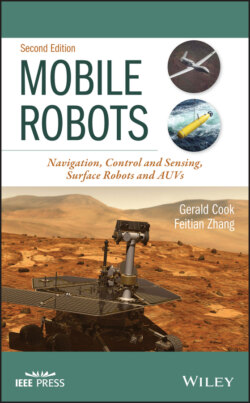Читать книгу Mobile Robots - Feitian Zhang - Страница 11
Preface
ОглавлениеA number of experiences and acquaintances have contributed to this project. The Countermine Branch of the Science Division of the Night Vision Electronic Sensors Directorate (NVESD), United States Army played a particularly important role through its sponsorship of related research. This research effort had as its objective the detection and geo‐registration of landmines through the use of vehicular mounted sensors. The nature of the problem required that a broad set of tools be brought to bear. These required tools included a vehicle model, sensor models, coordinate transformations, navigation, state estimation, probabilistic decision making, and others. Much of the required technology had previously existed. The contribution here was to bring together these particular bodies of knowledge and combine them so as to meet the objectives. This led to several interesting years of interaction with NVESD and other researchers in this area of applied research.
Afterwards, it was realized that the work could be cast in a more general framework, leading to a set of notes for a second‐year graduate course in Mobile Robots. A course on modern control and one on random processes are the required prerequisites. This course was taught several times at George Mason University, and numerous revisions and additions resulted as well as a set of problems at the end of each chapter. Finally, the notes were organized more formally with the result being the first edition of this book.
I would like to express my appreciation to some of the individuals who have influenced and encouraged me in the writing of this book. These include Kelly Sherbondy, my research sponsor at NVESD, former colleague Guy Beale, department chairman Andre Manitius, former student Patrick Kreidl, industrial associate Bill Pettus, collaborator at the Naval Research Laboratory Jay Oaks, former students Smriti Kansal and Shwetha Jakkidi who were part of the NVESD project, and the many other students who have attended my classes and provided me with inspiration over the years.
Gerald Cook
The major addition to the second edition of this book includes modeling and control of autonomous underwater vehicles (AUVs), which exhibits unique complex three‐dimensional dynamics. The materials are mainly based on my PhD research project on design, modeling, and control of a novel underwater vehicle named gliding robotic fish that is essentially a hybrid of underwater glider and robotic fish. The research, sponsored by National Science Foundation (NSF), aimed to develop an autonomous platform for aquatic environmental monitoring through fundamental understanding and effective control of gliding robotic fish, which eventually led to generalized modeling and control approaches for AUVs written in this book. I would like to acknowledge and thank my PhD advisor Xiaobo Tan, my collaborators Hassan Khalil at Michigan State University and Fumin Zhang at Georgia Institute of Technology for their enormous support and insightful guidance in the research project, and my colleague Gerald Cook for motivating and encouraging me in co‐writing the second edition of this book.
Feitian Zhang
The following is a suggested schedule for teaching a one‐semester course from this book.
1 Kinematic Models for Mobile Robots: 0.5 weeks.
2 Mobile Robot Control: 1.5 weeks.
3 Robot Attitude: 1.0 week.
4 Robot Navigation: 2.0 weeks.
5 Application of Kalman Filtering: 1.5 weeks.
6 Remote Sensing: 1.5 weeks.
7 Target Tracking Including Multiple Targets with Multiple Sensors: 1.0 week.
8 Obstacle Mapping and Its Application to Robot Navigation: 1.0 week.
9 Operating a Robotic Manipulator: 1.0 week.
10 Remote Sensing via UAVs: 0.5 weeks.
11 Dynamics Modeling of AUVs: 1.0 week.
12 Control of AUVs: 1.5 week.
It is hoped that this book will also serve as a useful reference to those working in related areas. Because of the overriding objective described in the title of the book, the topics cut across traditional curricular boundaries to bring together material from several engineering disciplines. As a result, the book could be used for a course taught within electrical engineering, mechanical engineering, aerospace engineering, or possibly others. We would like to acknowledge here that MATLAB® is a registered trademark of The MathWorks, Inc. Also, please note, two of the videos referred to in Appendix A can be viewed at https://www.wiley.com/en-us/Mobile+Robots%3A+Navigation%2C+Control+and+Remote+Sensing%2C+2nd+Edition-p-9781119534785.
